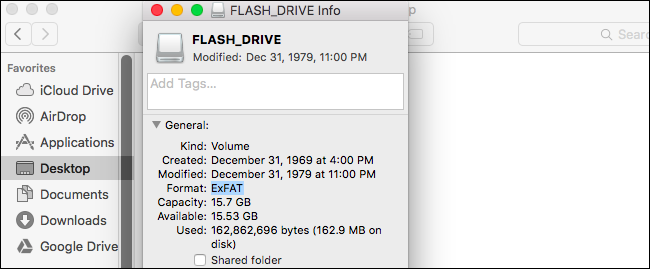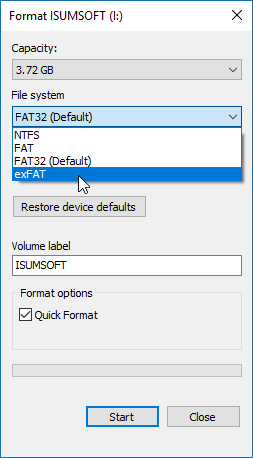


- #Format usb mac for windows for mac os x#
- #Format usb mac for windows password#
- #Format usb mac for windows Pc#
Native NTFS support can be enabled in Snow Leopard and Lion, but is not advisable, due to instability.Some have reported problems using Tuxera (approx $36).For 64-bit Snow Leopard, read this: MacFUSE for 64-bit Snow Leopard.
For 32-bit Mac OS X, install NTFS-3G for Mac OS X (free) (does not work in 64-bit mode). For Mac OS X 10.4 or later (32 or 64-bit), install Paragon (approx $20) (Best Choice for Lion). To Read/Write/Format NTFS from Mac OS X, here are some alternatives:. You can use this format if you only use the drive with Mac OS X, or use it for backups of your Mac OS X internal drive, or if you only share it with one Windows PC (with MacDrive installed on the PC). Mac OS X: Mac OS Extended format (HFS Plus) volume and file limits. To Read HFS+ (but not Write) from Windows, Install HFSExplorer.  To Read/Write HFS+ from Windows, Install MacDrive. Required for Time Machine or Carbon Copy Cloner or SuperDuper! backups of Mac OS X system files. Mac OS Extended (Journaled) Don't use case-sensitive) You can install MacDrive to enable that.įormat A Hard Drive Using Disk Utility (which is in your /Applications/Utilities folder) Windows cannot natively read/write to HFS+. If you install Paragon, Mac OS X can read/write to NTFS, as well. For simple file transfers, just use a USB flash drive, formatted as FAT32. Mac OS X can natively read/write HFS+, FAT32 and exFAT. Want to use external hard drive for time machine backup and media storage(iTunes). APM is an older, Mac-only partition scheme.How to use external hard drive on both Mac and Windows in Parallels Desktop? Cause You’ll also be asked to choose between a partition scheme: GUID Partition Map, Master Boot Record, or Apple Partition Map. RELATED: What's the Difference Between GPT and MBR When Partitioning a Drive? It’s not natively supported on many Linux distributions, but you can install exFAT support on Linux.įor external drives, it almost always makes sense to format in ExFAT, unless you’re using the drive for Time Machine. ExFAT is the ideal cross-platform file system. You should use this file system if you may share the drive with Windows PCs and other devices like the PlayStation 4 and Xbox One consoles.
To Read/Write HFS+ from Windows, Install MacDrive. Required for Time Machine or Carbon Copy Cloner or SuperDuper! backups of Mac OS X system files. Mac OS Extended (Journaled) Don't use case-sensitive) You can install MacDrive to enable that.įormat A Hard Drive Using Disk Utility (which is in your /Applications/Utilities folder) Windows cannot natively read/write to HFS+. If you install Paragon, Mac OS X can read/write to NTFS, as well. For simple file transfers, just use a USB flash drive, formatted as FAT32. Mac OS X can natively read/write HFS+, FAT32 and exFAT. Want to use external hard drive for time machine backup and media storage(iTunes). APM is an older, Mac-only partition scheme.How to use external hard drive on both Mac and Windows in Parallels Desktop? Cause You’ll also be asked to choose between a partition scheme: GUID Partition Map, Master Boot Record, or Apple Partition Map. RELATED: What's the Difference Between GPT and MBR When Partitioning a Drive? It’s not natively supported on many Linux distributions, but you can install exFAT support on Linux.įor external drives, it almost always makes sense to format in ExFAT, unless you’re using the drive for Time Machine. ExFAT is the ideal cross-platform file system. You should use this file system if you may share the drive with Windows PCs and other devices like the PlayStation 4 and Xbox One consoles.  ExFAT: ExFAT is almost as widely compatible as older FAT file systems, but doesn’t have the limitations. MS-DOS (FAT): This is the most widely compatible file system, but it has some limitations–for example, files can only be 4GB or less in size each. Avoid this file system unless you have a device that requires FAT32. OS X Extended (Case-sensitive, Journaled, Encrypted): This is the same as the standard OS X Extended (Case-senstiive) file system, but with encryption.
ExFAT: ExFAT is almost as widely compatible as older FAT file systems, but doesn’t have the limitations. MS-DOS (FAT): This is the most widely compatible file system, but it has some limitations–for example, files can only be 4GB or less in size each. Avoid this file system unless you have a device that requires FAT32. OS X Extended (Case-sensitive, Journaled, Encrypted): This is the same as the standard OS X Extended (Case-senstiive) file system, but with encryption. You’ll have to enter a password, and you’ll need to provide that password whenever you connect your drive to your Mac.
OS X Extended (Journaled, Encrypted): This is the same as the standard OS X Extended file system, but with encryption. This option exists because it matches the traditional behavior of UNIX and some people might need it–don’t select this unless you know you need it for some reason. By default, Mac OS X doesn’t use a case-sensitive file system. OS X Extended (Case-sensitive, Journaled): On a case-sensitive file system, “file” is different from “File”. This file system is necessary if you plan on using the drive for Time Machine backups–otherwise, you’ll want to use exFAT for maximum compatibility. OS X Extended (Journaled): This is the default, but it’s only natively supported on Macs. RELATED: What's the Difference Between FAT32, exFAT, and NTFS? You’ll need to choose between several file systems: You’ll be asked to provide a name for the disk, which will appear and identify the disk when you connect it to a Mac, PC, or another device. Select the drive by clicking its name.Ĭlick the “Erase” button after selecting the entire drive to erase the entire drive and create a single partition on it. Your connected drives will appear under “External” in the Disk Utility’s sidebar. You can also open a Finder window, select “Applications” in the sidebar, and head to Utilities > Disk Utility.








 0 kommentar(er)
0 kommentar(er)
